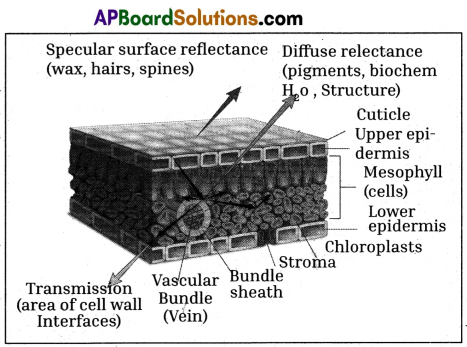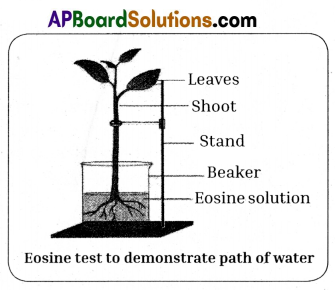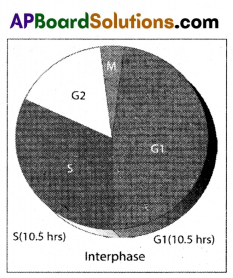Students must rely on TS 10th Class Biology Model Papers Set 7 to gauge their understanding of exam patterns.
TS 10th Class Biology Model Paper Set 7 with Solutions
Time: 1 Hour 30 minutes
Maximum Marks: 40
General Instructions:
- Read the question paper carefully and understand.
- Answer the questions under Part – A in the answer sheet provided.
- Part – A contains three sections : section – I, II and III.
- There is an internal choice to the questions under section – III.
- Part – B Answers should be written in the given brackets and attach to the Part – A answer sheet.
- Write the answers following the instructions given in each section.
Part – A (30 Marks)
Section – I (3 × 2 = 6M)
Instructions :
- This section contains 3 very short answer questions.
- Answer ALL the questions.
- Write answer to each question in 3 to 4 sentences.
- Each question carries 2 marks.
Question 1.
Explain the role of stomata in photosynthesis.
Answer:
- Stomata help in exchange of gases like CO2 and O2.
- Stomata help in preventing water loss by controlling evaporation.
Question 2.
What is respiration?
Answer:
Oxidation of food materials like glucose and fatty acids using the released energy and eliminating the waste products like CO and water.
Food + Oxygen → CO2 + Water + Energy
![]()
Question 3.
What is the function of Gastrovascular cavity ?
Answer:
Digestion and transportation of nutrients to each cell of the body in cnidarians is the function of Gastrovascular cavity.
Section – II (3 × 3 = 9M)
Instructions :
- This section contains 3 short answer questions.
- Answer ALL the questions.
- Write answer to each question in 5 to 6 sentences.
- Each question carries 3 marks.
Question 4.
Read the given para and answer the questions.
| We know that the nerve cell is the structural and functional unit of nervous system. Our nervous system consists of around about 10 billion of them, which communicate with each other in a specific manner. Dendrites of one nerve cell connect to the other or to the axons of the other nerve cell through connections called as a ‘synapse’. |
i) Define neuron.
ii) Where is synapse formed ?
iii) What are chief organs that are linked with 10 billion neurons ?
iv) How is neuron divided into parts ? What are they ?
Answer:
i) The structural and functional unit of nervous system is called neuron.
ii) Dendrites of one nerve cell connect to the other or to the axons of the other nerve cell through connections called synapse.
iii) Nerves are connected with Brain and Spinal cord.
iv) Neuron divided into 3 parts (a) Cyton, (b) Axon, (c) Dendrites.
Question 5.
How is the sex of a baby is determined ?
Answer:
- Sex of the baby is determined at the time of fertilization.
- A human male has XY sex chromosome and produces two types of sperms, either with X chromosome or with Y chromosome.
- A human female has XX chromosome, and produce ova of one type.
- If the sperm containing X chromosome fuses with ovam, the individual will be girl and the sperm containing “Y” chromosome fuses with ovum, the individual will be boy.
Question 6.
Rangaswamy has much of water facility in his well. He will always cultivate the wet crops. But remaining farmers are suffering from lack of water. What do you suggest him ?
Answer:
- You feel happy because you have plenty of water. But you don’t take it as a chance.
- As you grow up wet crops, the borewells of remaining farmers are drying up.
- In future, your well will also dry up. So we request you to please take care about that.
Section – III (3 × 5 = 15M)
Instructions
- This section contains 3 essay type questions.
- Answer ALL the questions.
- There is an internal choice for each question.
- Write answer to each question in 8 to 10 sentences.
- Each question carries 5 marks.
Question 7.
Write about the internal structure of the leaf.
(OR)
How can you prove that the water is transported through the xylem ?
Answer:

- A leaf is bounded on both sides by upper and lower epidermis.
- It is covered on both upper and lower epidermis by a wax like coating called cuticle.
- On the lower epidermis a large number of tiny openings called stomata are present.
- The opening of the stomata is called stroma. Each stroma is covered by kidney shaped guard cells.
- Transpiration and gaseous exchange process is controlled by the stomata present on the lower epidermis.
- Between the two epidermal layers loosely packed tissue called mesophyll is present.
- This mesophyll tissue is differentiated into palisade and spongy parenchyma.
- The palisade parenchyma which is closely packed without intercellular spaces contain more chloroplast than spongy parenchyma.
- Spongy parenchyma have irregular cells with intercellular spaces. These cells contain less chloroplast.
- In the centre of the leaf a mid vein is present.
- This mid veinuontains xylem towards upper epidermis and phloem towards lower epidermis.
(OR)
Aim : To prove that the water is transported through xylem.
Materials required : A plant bearing white flowers, jar and red coloured water.
Procedure : Take a plant bearing white flowers.
Place it in ajar containing red coloured water.
Leave it for an hour and then observe.
The flowers and of leaves turn red.
Inference : This shows that the water is being transported or carried up to the shoot through the stem.
But we have to prove that water is transported through xylem.
Take cross selection of the stem (cut the stem of plant taken for experiment horizontally).
Examine the thin section under microscope. You can find red spots showing that the water is transported through these parts which are called xylem.

![]()
Question 8.
What is the importance of cell cycle in the process of cell division ?
(OR)
Write about different types of contraceptive devices. How they are useful in the prevention of pregnancy?
Answer:
- The process of cell division is called ‘Mitosis’, which is completed in 40 to 60 minutes.
- The period between two cell divisions is called interphase.
- This is actually the period when the genetic material makes it copy. So that it is equally distributed to the daughter cells during mitosis. Interphase can be divided into four phases.
1. G1-Phase,
2. S-Phase,
3. G2-Phase,
4. M-Phase.
1. G1 Phase: This is the linking period between the completion of mitosis and the beginning of DNA replication. The cell size increases during this period.
2. S-Phase : This is the period of DNA synthesis leading duplication of chromosomes.
3. G2 Phase: This is the time between the end of DNA replication and the beginning of mitosis. Cell organells divide and prepare chromosomes for mitosis.
4. M-Phase : This is mitotic cell division. Cell fusion technique help to understand the functional relationship between these phases.

(OR)
- The prevention of pregnancy in woman by preventing fertilization is called contraception.
- Any device or chemical (drug) which prevents pregnancy in woman is called a contraceptive.
- The birth control methods can be of various types and can be used by any of the partners as preferable.
- Physical devices such as condoms and diaphragm are used.
- They prevent reaching of sperms to ova for fertilization.
- Chemical in the form of pills are induced either orally or inserting into female reproductive organ vagina.
- Pills for males are also available. These pills kill the sperms and hence are called spermicides.
- Use of intra uterine device called copper – T.
- Use of surgical methods such as vasectomy for males and tubectomy for females.
Question 9.
Peristalsis is an involuntary action ? Think how it was controlled ?
(OR)
“All the energy in the ecosystem is ultimately derived from sunlight.” Justify.
Answer:
- Peristalsis is involuntary action and under the control of autonomous nervous system.
- The wall of oesophagus is made up of two kinds of smooth muscles. The circular and the longitudinal muscles.
- The contractions of circular muscles result in narrowing of the oesophagus just behind the bolus and the food is squeezed downwards.
- The contractions of longitudinal muscles in front of the bolus widen the tube and bolus
moves forward. - Contraction and relaxation of these muscles bring in a wave like motion that propels the food bolus into the stomach.
(OR)
- All the organisms in an ecosystem derive energy from food.
- The food by its nature is the chemical energy and by in its stored form, it is the potential energy.
- In an ecosystem, all the consumers at any level depend upon producers for their food either directly or indirectly.
- The producers in any ecosystem are nothing but photosynthetic organisms such as plants, phytoplanktons and photosynthetic bacteria.
- Energy enters the producers in the ecosystem from the sun in the form of solar energy during photosynthesis.
- From the producers, the chemical energy passes to the consumers from one trophic level to the next through food.
- For example in a grassland ecosystem, grass traps the solar energy and stores in its body.
- When this grass is eaten and assimilated by insects this stored energy enters into the body of insects.
- From the insects it will pass to frog, from them to snake and so on to eagle.
- Thus, all the energy in the ecosystem is ultimately derived from sunlight.
Part – B (10 Marks)
Instructions :
- Write the answers to the questions under Part – B on the question paper itself and attach it to the answer book of Part – A.
- Each question carries 1 mark.
- Marks will not be awarded in any case of overwriting, rewritten or erased answers.
- Write the capital letter (A / B / C / D) showing the correct answer for the following questions in the brackets provided against them.
Question 1.
The chemical name of vitamin – E is
A) Tocoferol
B) Phylloquinone
C) Calciferol
D) Retinol
Answer:
A) Tocoferol
Question 2.
Fixed air = CO2:: Vitiated gas =
A) Hydrogen
B) Nitrogen
C) Oxygen
D) Carbonate
Answer:
C) Oxygen
Question 3.
These are the respiratory organs in aquatic animals like Crocodile and Dolphin
A) Gills
B) Skin
C) Lungs
D) Trachea
Answer:
C) Lungs
Question 4.
This shows

A) Transpiration
B) Respiration
C) Transportation
D) Photosynthesis
Answer:
D) Photosynthesis
![]()
Question 5.
Absence of the following hormone produces dilute urine
A) Insulin
B) Vasopressin
C) Thyroxine
D) None
Answer:
B) Vasopressin
Question 6.
Special excretory organs are absent in
i) coelenterates
ii) sponges
iii) Amoeba
iv) paramoecium
Correct answer is
A) (i) and (ii)
B) (ii) and (iii)
C) (iii) and (iv)
D) (i), (ii), (iii) and (iv)
Answer:
C) (iii) and (iv)
Question 7.
Contractile vacuoles are the excretory organs in
A) Amoeba
B) Hydra
C) Paramecium
D) A and C
Answer:
B) Hydra
Question 8.
Medulla oblongata coordinates reflexes like
A) swallowing
B) coughing, sneezing
C) vomiting
D) all of these
Answer:
C) vomiting
Question 9.
Consider the following.
a – Girls only after 18 years of age can be said to be prepared for the marriage, b – Every year 21% of teenage mothers die during delivery.
A) both a & b are true b explains ‘a’
B) both a & b are true, b doesn’t explain ‘a’
C) a is true, b is false
D) a is false, b is true
Answer:
A) both a & b are true b explains ‘a’
Question 10.
See the picture of pollen grain. What sort of division helps in its formation ?

A) Mitosis
B) Unequal division
C) Meiosis
D) Unnatural division
Answer:
D) Unnatural division